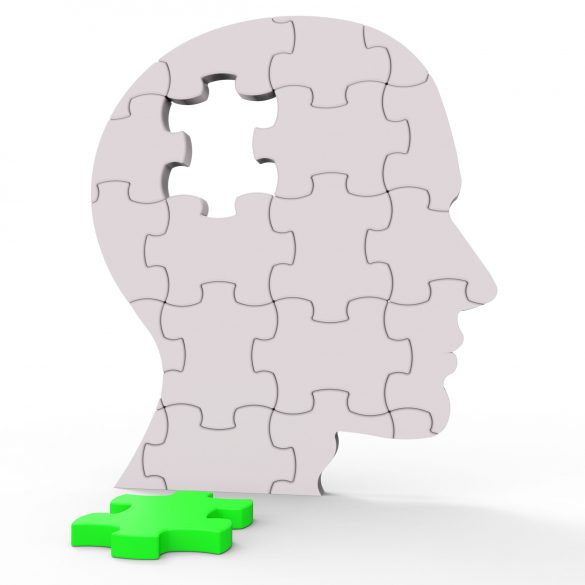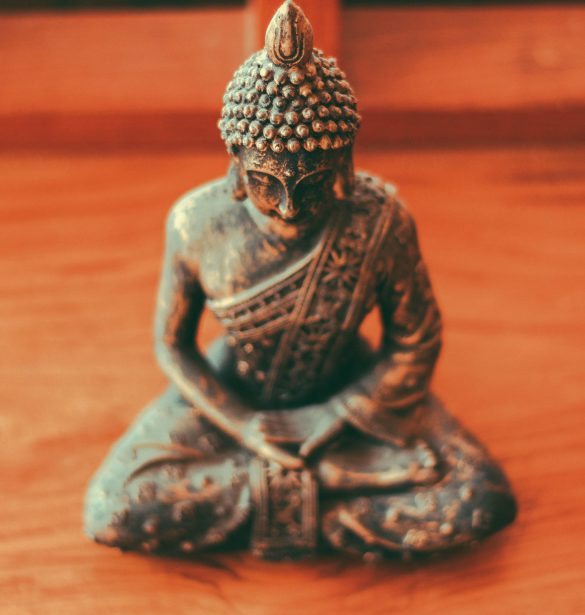Our mind, our mindset is a huge topic I’m addressing on my blog. It is this enormous entity, which covers so much more than we can even imagine. In fact, our perception on what the mind actually is can be regarded as limited. Some of you would try to describe it as thoughts, logic, rational part, intellect, mechanics in the brain – these are attempts to rationalize this mystical aspect called “mind” by our own intellect.
As there definitely is a significant difference between the brain and the mind and as there are so many attempted definitions and explanations out there, I want to dive into this jungle of information and share with you the essence I personally took out of it.
So, before we dive deeper into further topics relating to our mind in my next articles, first of all we should take a look at our perception of the mind itself: What is it really? How does it work? How is it related to our physical entity? Does a definition even exist? And what is the yogic perception of this non-visible phenomenon that we as a western population call “our mind”?
Mind.
A beautiful servant. A dangerous master.
(Osho)
Learn, expand and simply enjoy these shared lines of mine … let’s dive head-first into this fascinating topic!
~ What is the mind? ~
There are two approaches in trying to define “mind”, if you go ahead and compare the more western science approach and the ancient cultural, rather spiritual approach. Yet on some level, spirituality and science intertwine with each other.
A rational definition says that you can imagine, think, study and form ideas with the power of your mind. It is related to your brain and functions on a set of cognitive faculties. This perception may regard emotions more subjective and “separated” from the mind. But what separates one from the other?
 I once heard a beautiful definition, rather spiritually related, which says: The mind is a fluctuation of the universal consciousness, for every thought is connected through the global collective consciousness, which is further connected to the universal consciousness, which contains all thoughts and knowledge. Our fluctuations go from extremely positive to violently negative energy. There are even suggestions that say your mind isn’t localized to your body, it may exist externally or in different areas or parts of your physical entity.
I once heard a beautiful definition, rather spiritually related, which says: The mind is a fluctuation of the universal consciousness, for every thought is connected through the global collective consciousness, which is further connected to the universal consciousness, which contains all thoughts and knowledge. Our fluctuations go from extremely positive to violently negative energy. There are even suggestions that say your mind isn’t localized to your body, it may exist externally or in different areas or parts of your physical entity.
“You are where your mind is.”
(Radhanath Swami)
You’re probably doubting or not able to agree with any of these approaches, as the first one sounds too limited and the second one a little “spooky” to you. There is one definition I very resonate with, for you can grasp it as a rather understandable explanation and it is widely accepted as well. It says that the mind is essentially comprised of two parts; you’ve probably heard of those: the conscious part, which represents only around 10% of the total volume of the mind and the subconscious part that lies below the level of conscious awareness and comprises the dominant volume.
~ Conscious and subconscious mind ~
You probably agree with this approach of having a conscious and subconscious part of the mind. As the conscious level only constitutes a very small portion of our mental processes, it can’t be used synonymously with the word “mind”. Meaning, all of the thoughts you realize consciously throughout the day are a tiny little part of your complete mind, you might compare it to the peak of an iceberg that can be seen above the surface of the water, whereas the huge subconscious part has its almost infinite roots underneath. Another metaphor you can imagine is the fluctuating waves on the surface of the oceans seen as your conscious mind and the tremendously deep ocean beyond as your subconscious mind.
The fascinating world of the subconscious mind can be further divided into three parts, to give you a more clear understanding:
First, we have the primitive or primal mind, which represents our automatic nervous systems. Thus, it controls our physiology, all biological processes, our fear response, etc.
Secondly, we have the upper sub-consciousness part, also called our internal computer or autopilot. It works on programs we’re streaming and plays them over and over again. Especially in the first 7-8 years of our life, this internal disc records everything it gets in touch with outside of us. These manifestations comprise our personalities, attitudes, values, beliefs, they represent our habits, govern most of our behaviors and emotions. This part needs to be programmed, for it gets programmed anyway, mostly automatically and independently, if we do not pay attention to our thoughts, actions, and habits. We can also call it the “unconscious mind” as everything on this level happens without our awareness. It causes us to react to situations in a way we were programmed rather than respond to it with our full awareness. Thus, it plays a huge role how we are programmed: self-empowering or rather self-devaluating and self-deprecating? The more mindful we are, the more “present” we are, the greater ability we have to respond in a way that serves our growth, our well-being, and our greater good.
“Until you make the unconscious conscious,
it will direct your life and you will call it fate.”
(Carl Jung)
And thirdly, there is the lower sub-consciousness or “super-consciousness”, which can be referred to as spirit or soul or our true essence. It literally is our state of innate unconditional love and self-esteem, with which we were all born. A part that connects us to the energy of the universal creation.
~ Mind vs. Brain ~
A common perception of the mind is its localization to the brain. But let’s take a more detailed look on this presumption: the brain is a physical organ within our body. It represents symbolically a qualia networks, meaning the subjective perception of the world through our sensory systems, in a living entity. However, the mind goes far beyond this – as you could call it – “limited” perception.

“The mind is in every cell of your body.”
(Candace Pert)
As we perceive our head, in fact, our brain to be the center of the thinking process, it seems obvious to put the mind into this physical area and equate it with the brain. That might be correct, at least to some extent. However, our mind goes far beyond the mere process of thinking and perceiving the world through the physical senses. Let’s compare these two parts directly with each other:
- As the brain consists of nerve cells and blood vessels and moreover, has a definite shape, the mind does not; but it might rather be conceived as an energetic, non-visible fluid.
- The brain is the center of the nervous system. That means, it interacts via nerve cells with the periphery of our organism, it coordinates movements, thoughts, and feelings. On the other hand, the mind refers to a person’s understanding of things without any relation to our physical entity. Actually, it refers to his conscience.
- The brain functions as a mirror for the physical universe and it is conditioned. It relays information to the mind and from the mind to the senses. You can say it vibrates as an instrument to the mind.
When you think of your body in a relaxed state, sitting or lying down, yet your mind might be busy jumping from one thought to another; recalling an uncomfortable situation in the past or worrying about difficulties in the future – aren’t these indications that body and mind are not the same entity? Another example is that of the physical death when our brain as part of the body perishes as every other cell does. However, the consciousness as an invisible energy won’t vanish likewise. This is because energy, as has been scientifically proven, is unable to disappear.
The mind may be seen as a formless continuum and therefore not obstructed by physical objects. It is a conglomerate of all qualia experiences within consciousness and not limited to one’s subjective, sensory experience of the so-called objective reality.
~ The Yogic perception ~
As I personally learned about the perspective of Yoga on the mind during my YTTC in India, I’m curious to share with you this rather complex, but very interesting and truthful approach.
In the Yogic system, the mind is comprised of 16 parts, which are categorized in four fundamental areas:
- Buddhi (“intellect”): The intellect is a useful tool, a survival instrument, yet in modern society, we pay too much significance to it. You can compare it with a knife – everything is dissected. Modern science is coming out of human intellect: everything is dissected and wants to be understood from a reductionist perspective.
- Ahamkara (“identity”): This part includes everything you’re identified with, also translated as the “I am-ness”. Intellect is an instrument, which protects the identity you’ve taken on. Identity is an instrument, which allows the intellect to function in a certain way (as you perceive yourself). How consciously and how steadily your identity is created will determine the effectiveness of your intellect. Whether your intellect works productive or destructive is determined by Ahamkara – it can be regarded as the hand that holds the knife (Buddhi).
- Mana (“memory”): This memory holds every information that happens on this planet. It is the coordinator of the senses and the mental creations, such as thoughts or images. The energies of Mana are rather collected. We are who we are only because of the memories that we carry. Memories create patterns, which then create physical forms.
- Chitta (“storage of impressions”): You can perceive Chitta as this huge space that carries memories, experiences, information even from previous lifetimes, therefore all impressions within you. It might be very useful but can also cause difficulties. This part of your mind is always on, also when you’re asleep. It needs to be there as it keeps you alive; thus, it can be perceived as the huge dimension of our sub-consciousness. You’ll also find Chitta defined as “pure intelligence”, as a dimension of intelligence, which is the linking point to our consciousness. If you touch it, your intelligence will become boundless, you’ll receive access to everything, to the source of creation.
As the second yoga sutra says “Chitta Vritthi Nirodha”, the goal of practicing yoga in a holistic way is to still the mind in order to experience ultimate reality. As soon as all the busy thoughts in our mind are calm, we’re reaching a natural state of tranquility and will be able to move towards Self-realization.
~ Conclusion: The power of your mind ~
Coming up with a specific and general definition of the mind is a challenging task. As you can tell from this whole article, there are many perceptions that try to approach this complex topic of our mind. I may tell you that the mind is much more than you probably think it would be and – what’s further important – your mind has an incredible power you would not dare to believe.
I’d love to hear your opinion on this topic. Do you resonate with what I came up with?
The final words of this article will be dedicated to the Master of the mind, Buddha – simply absorb what he once said, let it dwell within you and reflect:
We are shaped by our thoughts; we become what we think.
When the mind is pure, joy follows like a shadow that never leaves.
(Buddha)
Om śānti śānti śānti!
Namasté,
yours Isabel!
Pictures
Unsplash (www.unsplash.com)






Liebe Isabel!
Meine Antwort auf deine Frage: “Kannst du mit meinen Erläuterungen etwas anfangen?”, lautet:: “Jein”!!!!!!!!
Die Begriffe Bewusstsein und Unterbewusstsein sind mir sehr vertraut ebenso Gehirn, Gedanken und Geist.
Die kräftigste Aussage, meiner Meinung nach, ist die von Buddha, das du als Schluss-Zitat. eingesetzt hast. Das erklärt alles.
LG von Mum!
Liebe Mama,
vielen Dank für deinen ehrlichen und lieben Kommentar zu diesem Artikel.
Das Thema ist tatsächlich ein recht komplexes und sehr umfangreiches. Es war ehrlich gesagt ziemlich herausfordernd, meine persönliche Essenz so kompakt und verständlich wie möglich niederzuschreiben. Aber wie du auch sagst: kurze Worte, die eine Menge Weisheit in sich tragen (s. Buddhas Zitat), sind oft aussagekräftiger als lange, umfassende Erläuterungen.
Ganz liebe Grüße,
Isabel!
Dear Isabel,
I would like to share my own experience of my own college days. Once we did a project of Brain Computer Interface just to prove how can one be in resonance with the Mother Earth. We recorded brain waves of a monk doing meditation and yes we noted some conclusions. The Earth actually sings or hum at a particular frequency which sometimes get variated due to tectonics plates movements. So with meditation the monk tried to reduce the frequency of brain waves to as close as to the earth frequency. Although it was highly difficult and theoretically one have to dead to actually listen to the hum. Since it was not at all possible, so the experiment conclusion were not complete, but yes we noted some pretty amazing phenomenas
1. You can listen to the earth and talk. Even Earth is a complete living being just like humans. Even trees have feelings and when we cut them, they feel pain in a different way though and they also talk.
2. The Periodic Spikes of Brain Waves resonates with the objects around them (In the experiment).
Well there were many more conclusions, the point was, our mind is actually unimaginable powerful, still unknown how much.
Thanks
Siddharth
Hello, Siddharth!
Thank you very much for the comment and especially for sharing your experience on this almost non-tangible topic of our mind.
It really highlights the complexity of this topic and as you said, much of it is still unknown … as we predominantly try to explain everything with our “limited perception” of the brain. Further articles on this topic will be available soon and I’m always excited about people’s view/ perception/ approach/ opinion. So, I’d love to hear from you again! 🙂
Thanks a lot for sharing & Namasté,
Isabel!